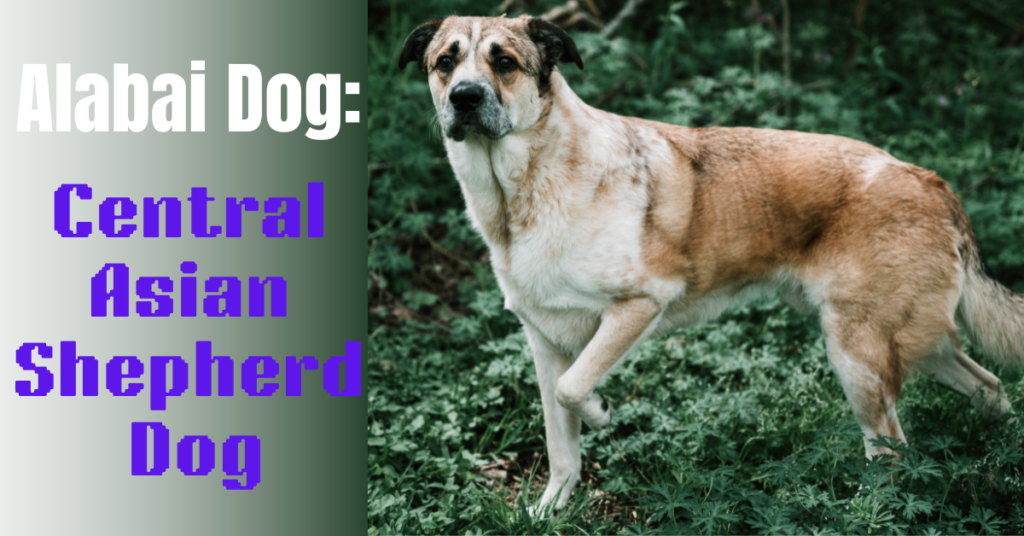The Central Asian Shepherd Dog is the Alabai dog. It is a big breed. They have been for more than 5,000 years. They were originally employed as sheep and goat guard dogs. Also to serve as a shepherd dog in modern times.
The Alabai is also helpful in protecting the loved ones. And belongings of nomadic cultures. The Central Asian Shepherd Canine is a rare and historic breed. Sometimes referred to by the names Turkmen Wolfhound, Ovcharka, Alabay, or Alabai dog.
This beautiful species, which has a reputation for power, liberty, and guarding feelings, came from the wide territory of Central Asia. These brave canines have long served as protectors of property and cattle.
This type of dog is distinguished by its impressive size, with boys usually weighing from 110 to 170 pounds and females weighing anywhere from 80 to 120 pounds. They also have a brave and curious nature.
Along with their robust, muscular build, they also have a thick dual coat that makes them stand out. Guardian dogs are usually quite reclusive. And are popular for their commitment to their families. Because of this and their background as working dogs, early introductions and careful training are important.
They may be distant from outsiders. But they develop close relationships with the people. Who owns them and are strong defenders of those they care about. Those who value the characteristics of this age-old. And respectable breed matched with these loyal and trustworthy friends.
Please take note of that. Inexperienced or first-time pet owners may not be suitable for this breed. Buying from rescue groups or shelters should be your top priority. When thinking about getting a Central Asian Shepherd Canine to provide a needy dog a loving home.
But if you choose to buy a puppy, it is important to pick a reliable breeder of Central Asian Shepherd Dogs. Make sure the breeder promotes the welfare of their pets. And keeps to legal requirements by doing an in-depth investigation.
Good breeders of Central Asian Shepherd Animals put their dogs’ personalities and health first. Perform the required health exams and offer their puppies a loving home. This proactive strategy discourages illegal methods of breeding. And guarantees that you will bring home a happy and healthy puppy.
Fast Facts Origin: Central Asia.
Dimensions: 22–28 feet in height, 110–220 pounds in weight.
The kind: Herding Ten to fifteen years of life.
Coat: A thick, two-layered coat that can be medium-sized. Short, or black, white, brown, sable, or brindled in color.
Exercise requirements: Moderate to high.
Behavior: Trustworthy, safeguarding, devoted, and smart.
Training: Willing to make others happy and simple to train.
Health: Generally good. But subject to some medical ailments. Including elbow and hip dysplasia and eye issues.
An old vase from 2000 B.C. that was found in northern Iran depicts a shepherd with dogs. They look like modern-day Central Asian Shepherd Dogs. It is currently on display at the Museum of the Louvre in France.
Highlights of Central Asian Shepherd Dogs’ Guardian Instincts
Because they have historically been responsible for watching over animals. Central Asian shepherds have a powerful and natural protective sense. They can be fierce protectors of their loved ones and their house and are famous territorial.
Size and Strength: The size and strength of this breed make it noteworthy. Males weigh around 110 and 170 pounds. While females average from 80 and 120 pounds.
Their powerful height and strong physique help them be good working and security dogs. Flexibility: In Central Asia. Shepherds from Central Asia have survived a variety of harsh conditions.
Their toughness makes them adaptable to a variety of climates and environments. And their dense double coat offers protection against extremes of temperature.
Independence: The autonomous disposition of these canines is popular. Even if they have close relationships with their relatives. They might be a little distant from others, especially when it comes to strangers. Their past function as working dogs. Who needed to be independent reflected in their attitude.
The Central Asian Shepherd breed is extremely attached to their families. They develop close relationships and are devoted. Especially for people whom they know and respect. Their success as protectors and faithful friends is attributed to their loyalty.
Historical Significance: The Central Asian Shepherd, having a centuries-old pedigree, has been integral to the nomadic peoples of Central Asia. The breed is more attractive to people who are interested in canine customs. And historical working breeds because of its historical relevance.
Dog Health of Central Asian Shepherds
A part of the risks of the Central Asian Shepherd Canine has been eliminated by natural selection. This puppy has gradually developed genetic resilience. They are a highly healthy dog that doesn’t seem to have any breed-specific problems. But, because of their size, they might be more vulnerable to a few ailments.
Hip deformation: When a dog’s hip joint does not fit correctly into the hip socket, it is known as hip dysplasia. This defect may cause pain and injury, which would limit the dog’s range of motion. Von Willebrand’s Illness:
A coagulation protein called von Willebrand factor is deficient in Von Willebrand’s illness. A genetic clotting illness. After wounds or procedures, dogs with this disease may have persistent bleeding.
Bloat, also known as stomach inflation and pressure, or GDV. It is a potentially fatal illness in which the stomach overflows with gas and twists around on itself. This is regarded as an emergency in medicine. Since it may cause internal organ damage or a limit in blood flow.
That gradually leads to damage to the retina. It usually causes a gradual loss of eyesight and can finally cause blindness.
Care for Central Asian Shepherd Dogs
As with any dog. It’s important to schedule routine medical examinations for your Central Asian Shepherd Pet. To identify any health issues early on. Developing a care routine might help by a doctor.
Despite having a lot of stamina. The Central Asian Shepherd Puppy is not considered a high-energy breed. Each day they need roughly one hour of activity.
It’s best to go trekking or walking. Once or twice per month, or as desired, clip the nails to avoid them from growing too long. They should not be making noise in response to the floor.
Here’s where your veterinarian or groomer may be helpful. Maintaining the dental health of all pets is the challenging duties involved in pet care.
Clean your dog’s teeth at least three times a week. Your veterinarian provides advice on dental treats. And show you the right way to clean the dog’s teeth.
Feeding of Central Asian Shepherd Dogs
A huge breed with limited energy needs a diet designed specifically for Central Asian Shepherd Dogs. For this breed, a single daily serving of premium dog food or homemade treats may be ideal. Seek guidance on part quantities and timing from your veterinarian.
Shepherds from Central Asia Overfeeding can cause dogs to put on weight. So you should follow a routine of feedings and avoid leaving food available during the day. Also, restrict how many sweets they receive.
Like other dogs, Central Asian Shepherd Dogs will experience changes in their nutritional requirements from childhood to maturity. And even into old age. As a result of far too much diversity in particular dogs result in increased size energy, and health.
You should seek a doctor for advice about the nutrition of the Central Asian Shepherd Dog. The color of a Central Asian Shepherd canine coat and maintenance. The coat of a Central Asian Shepherd Dog can be any color. Although the most popular shades are white, fawn, black, and brindle. Their coats might be solid colors or a mix of several colors at different periods.
They are simple to take care of even though they are not a good choice for allergy patients. They typically have medium-length, in straight-line thick fur.
To maintain them appearing and feeling their best. Their furs must be brushed likely once a week and bathed as needed. The garment will alter with the changing of the seasons.
In general, it is denser in the colder months and thinner in the summer. They often develop quite thick underneath in the winter.
It is important to remember that Central Asian Shepherd Dogs have an annual shedding season. It is known as “the fur rain.”
If you plan to take in one of the above beautiful animals. Check that the vacuum is ready or think about getting a robot cleaner.
The Central Asian Shepherd Puppy can withstand extreme cold. And covered by a thick overcoat. But it dislikes extreme heat. The entire family should live indoors with this puppy.
3 Benefits and Drawbacks of Having an Alabai Dog Simple to care for
Benefits
- Alabais need weekly brushing, making them quite simple to groom.
- Excellent relations with other animals: In general, Central Asian Sheep Canines get along well with cats and other kinds of dogs.
- Alabais are brave and will defend their family in a protective manner.
- If they feel attacked, their 500–650 pounds per inch of surface bite force defends their bark.
Drawbacks!
- Huge: Alabais are a huge breed that needs a lot of room and nourishment.
- Can be tough to train: Because Alabais are a highly independent breed, obedience training may be more challenging.
- Apartment life is not recommended for Central Asian Shepherd Dogs. These dogs need a wide fenced-in area for their living quarters.
Also Read: Cane Corso Dog: Complete Insight Height, Weight, and Health








